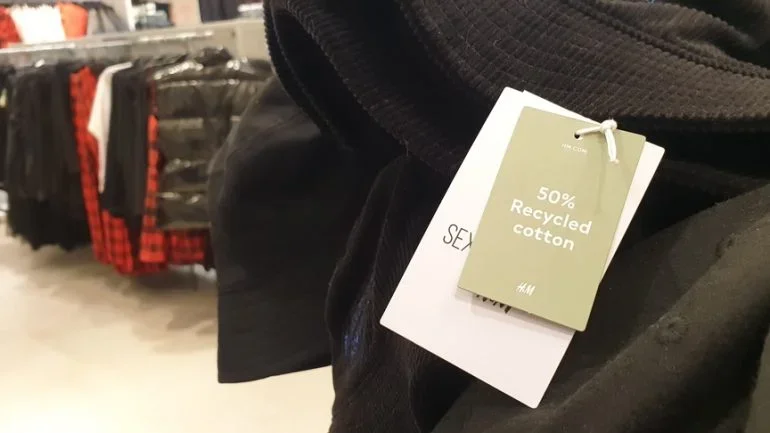Man-made polyester remains the biggest fibre on the apparel market and its market share continues to grow, but given the ongoing focus on sustainability, could its natural competitor cotton make a comeback in the not too distant future? Just Style investigates.

The biggest story in terms of volumes of growth in recent years is polyester, according to Alexei Sinitsa of data and analytics company Wood Mackenzie.
In terms of total mill consumption worldwide polyester is continuing to escalate its share with China leading the charge and growth in the wider South Asia region proving to be something to “be reckoned with,” he tells attendees of the IAF and ITMF’s joint annual conference in Samarkand, Uzbekistan.
He continues: “The biggest fibre is always polyester and if we take a look at where it’s being produced – we see the dominance of China increasing over time.
“If we look at polyester, fibre production and growth in China is 73% by 2030 and the rest of Asia plus China is 92%.”
Polyester is a man-made fibre that is deemed to have many advantages. Notably, it can go into any application and its man-made properties mean it can fulfil all future demand, shares Ajay Sardana of petroleum refining company Reliance India.
He describes it as a “magical fibre” and highlights its versatility in design and use, its good blendability, lightweight and breathable properties as well as its ability to be used as an alternative to viscose and cotton.
Polyester’s main challenges
Florian Heubrandner, vice president global business management textiles of wood-based viscose fibre producer Lenzing predicts consumers will undertake more conscious spending in future and will demand products that have longer lives and reusable possibilities.
Despite the apparel sector’s focus on sustainability, recycled polyester still only accounts for 15% of the total polyester textiles used today, according to Gherzi Textile Organization partner Robert P. Antoshak and Grey Matter Concepts SVP of production and sourcing Radhika Shrinivas.
Stefan Hutter, the owner of fabric and textiles development company Santis Textiles, admits fibre recycling is still at the very early stages in many cases. “The train is still at the station and just starting to roll,” he states.
But, he argues: “Today I can see polyester recycling is much further compared to cotton recycling. The technologies today can do a lot more than we see on the market – we can introduce our technology to more markets in the world.”
Heubrandner agrees, adding at Lenzing objective is to develop technology further and make it [recycling[ part of the mix in future.
Why has interest in cotton declined?
Cotton Analytics’ Terry Townsend argues cotton is not keeping pace with major competing crops and it’s not competing in terms of hectare. He shares: “We’re seeing a shift worldwide away from cotton towards other crops.”
Plus, it faces competitor pressures from its man-made rival polyester.
There are also negative tropes about cotton and agriculture and these have become embedded and accepted as the norm in public perception. This includes GMOs being dangerous, fertilisers being toxic, pesticides being harmful and only organic being seen as good.
He believes cotton is being targeted and Uday Gill, the former chief strategy officer and executive director of sustainable chemical company Indorama Ventures PLC agrees, stating: “Cotton has received a bad rep in recent years”.
Gill adds: “There’s huge misinformation around cotton with people calling us out for so-called fashion crimes and dirty cotton. I don’t think we deserve all these campaigns and misinformation against us.”
He’s keen to dispel the myths surrounding cotton and believes once consumers understand its benefits their attitudes could change in future.
He points out the statistic about it taking 20,000 litres of water to grow the cotton needed for a t-shirt is 20 years old and was not peer-reviewed.
“Any crop uses only a transient amount of water – it takes water from the ground and it consumes only a small fraction of that for the plant, and that’s true of all plants including cotton.”
He explains the second myth is that cotton competes with food crops, but he argues cotton is a food crop and a fuel crop and then a fibre crop.
Another myth is that cotton consumes 25% of the world’s pesticides and insecticides, however Gill explains it’s “actually 5% and we can do even more to reduce it through regenerative farming”.
Does a sustainable textile future need cotton at its core?
A huge benefit of cotton is that it is biodegradable: “It’s a natural fibre so does not contaminate and it blends well with other fibres and improves the functionality of other fibres,” share Gill.
He asserts the cotton industry can improve its environmental impact in terms of water impact and farm use and he goes as far as to say “cotton is a textile lifeline, so we have to create an ownership of this and collaborate.”
He adds: “Building a future for sustainable textiles needs cotton at its core.”
Gill believes the ITMF has a chance to lay the foundations for sustainable cotton: “We need to create a common platform to connect farmers, research institutions, manufacturers, regulators and brands.
“We need advocacy for cotton to bust myths against cotton on social platforms
“And we need to encourage regenerative farming to reduce its environmental impact and be the torch bearer for the sustainable world.”
Townsend sees technology as being key to cotton’s comeback and claims demand alone will not save it.
He says: “There are countries seeing increased yields – Brazil and Australia are seeing it going up, however countries that don’t use technology stagnate. For instance yield in West Africa lags behind the US, Brazil and Australia.
“We’ve got to have technology for cotton to keep pace in the world economy.”
Townsend asserts Gill is right to want to correct cotton’s myths and the wider sector needs to work harder on its marketing to change public perceptions, but it’s also about cultivating a wider acceptance of agricultural technology.
For Gill, cotton’s future lies in improving cotton’s functionalities as it already benefits from being natural and having biodegradable qualities.
Consumers talk with their hard-earned cash and the purchases they choose to make whereas “the research currently being carried out by institutes and universities is focused on farmers as stakeholders and not on what consumers need”.
Given demand is key, he urges the cotton sector to investigate whether consumers want a softer cotton or a more absorbent one and believes getting these answers should be a priority.
Cotton recycling also offers new possibilities for cotton with Townsend stating recycling cotton fibres into other products has been going on for decades, but he adds: “There’s scope for expanding the use of recycling and repurposing cotton fibres and all fibres.”
Source from Just Style
Disclaimer: The information set forth above is provided by just-style.com independently of Alibaba.com. Alibaba.com makes no representation and warranties as to the quality and reliability of the seller and products. Alibaba.com expressly disclaims any liability for breaches pertaining to the copyright of content.



